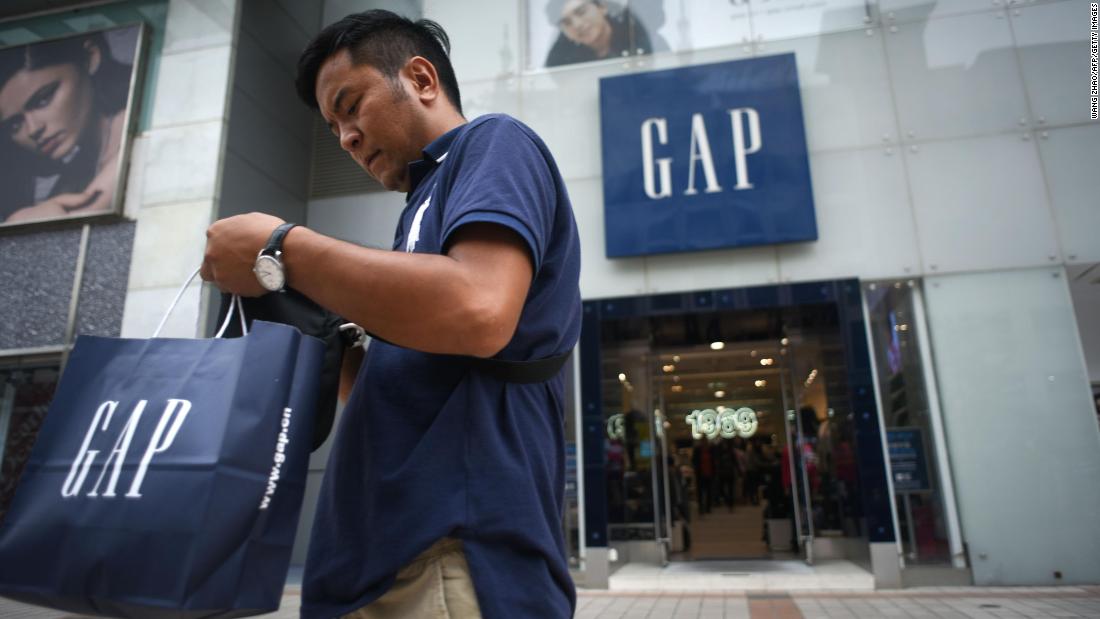
The Gap was the coolest brand in retail two decades ago. It rode the mall boom in the back-half of the 20th century and won over everyone from teens to moms to celebrities like Sharon Stone.
But Gap (GPS) has been adrift for years, punctuated Tuesday by a 7% sales drop during its latest quarter compared to the same time last year.
Gap built its status on selling logoed sweatshirts, turtlenecks, and fashion basics for premium prices, yet that model is under threat with more choices in the market than ever before.
"They operated in the day when the chief merchant was king, and only a select few people had the right to dictate fashion," said Simeon Siegel, a retail analyst at Nomura Securities. "Now, anyone with an Instagram handle has the right to opine on fashion."
Gap chief executive Art Peck admitted on a conference call with analysts Tuesday that the company thought it could solve its problems by adding more selection to its stores, entering new markets, and growing sales. "We have at times kind of crossed our fingers and hope to grow our way of the problem," he said.
Not anymore. Gap understands it's too big and will never be what it once was.
The company outlined a new plan to aggressively close under-performing stores on Tuesday. Ripping off the Band-Aid could mark a turning point for Gap and prevent it from fading away entirely.
Retail's worst performer
Gap's slump last quarter, which was even worse than JCPenney (JCP) or Victoria's Secret's (LB) results, comes at a time when retailers are taking advantage of a strong US economy and Americans spending more on everything from clothes to new televisions.
The Gap brand's issues contrast with bright spots in other areas of the company, too.
Sales at Old Navy, Gap's largest brand, grew 4% last quarter. Old Navy is building new stores and will reach $10 billion in sales in the coming years. Gap's women's athleisure chain Athleta is expanding too, and the company expects it to hit $1 billion in sales.
The company has also successfully revitalized Banana Republic under new leadership in part by closing weaker stores. Banana Republic has reported four straight quarters of same-sales growth.
Old Navy, Athleta, and Banana Republic combine for close to 70% of the company's nearly $16 billion in sales, and they're in strong shape.
"Old Navy is a machine," Jefferies analyst Randal Konik said in a research note Wednesday. "Athleta is a major long-term growth vehicle."
But years of missteps and a changing retail landscape have caught up to Gap's core brand.
Missed opportunities
"Management lost track of its shoppers and competition," said Wendy Liebmann, chief executive of consulting firm WSL Strategic Retail.
Gap fell out of touch with Baby Boomers that grew up on the brand and failed to attract Millennials that drive fashion trends today. At the same time, retailers such as Levi's, Target (TGT), and fast-fashion sellers H&M and Zara lured away Gap's denim shoppers with cheaper prices and trendier styles.
"They even cannibalized themselves, selling so many of the same styles at Old Navy and Banana Republic," she said.
Gap is having trouble clearing out inventory.
It is carrying too much stuff, including three times as many tops as bottoms, and its prices were too high. Gap's merchandising and pricing mistakes weigh on its profitability since Gap has to resort to deep discounts to sell them.
"Gap's brand image is still lackluster and it is not bringing anything new or exciting to the market," said Neil Saunders, managing director at GlobalData Retail. "Products are still samey and boring."
In addition, Gap lacked the right plan to capitalize on the huge opportunity in the shift to athleisure. Despite success with Athleta, Gap did little to solve the problem in its main business. Earlier this year, Gap finally introduced an active line for men.
Jeff Kirwan, the CEO of the Gap brand, resigned earlier this year. Gap replaced Kirwan with Neil Fiske, a former Billabong executive who helped turn around Bath & Body Works.
Shrinking to grow
Half of Gap's sales come from online channels and outlet stores. Both of those divisions are growing and profitable.
But more than 1,000 flagship stores around the world— many of them in near empty-malls— account for the other half of the business. At the beginning of November, Gap had nearly 800 stores in North America.
Peck believes Gap's current store count is unprofitable, and he sketched out plans to quickly close hundreds of them Tuesday. Taking actions, which he called "overdue," could save Gap up to $100 million in profit and boost healthier stores.
"We have had a lot of stores that are in the bottom half of the fleet that have continued to deteriorate over time," he said. "It's my strong belief that we've kicked the can down the road on this and offered a deteriorating customer experience, and it does have a negative effect on the health of the brand."
Gap recognizes it overextended and revenue has peaked. Analysts argue the plan to shut doors could help it become a sustainable business in the long run.
"Not only should the closure of weak stores eliminate significant losses, but it should also elevate the brand position and allow management to focus on stronger performers," Konik said.
A similar strategy has worked for chains like Ralph Lauren and Michael Kors. The two drastically shrunk their inventory, but that paid off because fewer prices led to higher prices, Siegel said.
"The largest brands realize you can be healthier if you're smaller," he added. "Profits can go up if sales go down."
Wall Street liked the sound of a new, smaller Gap. Gap's stock price rose 5% on Wednesday.
No comments:
Post a Comment